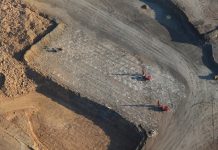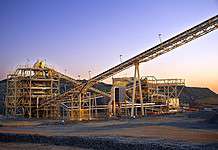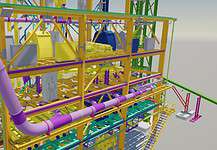HEIGHTENED risks associated with wet tailings dams, as well as cuts to water allocations in mining projects, impelled FLSmidth to seek a solution to dry tailings systems that would be cost efficient for larger mines.
The solution IT developed, with a functioning system currently operating in an iron ore project in WA, is economical for mines with a throughput of more than 30,000t of dry stack tailings a day, and can also be applied to mines with lower production levels.
Dry tailing systems cut costs and risk.
The elimination of wet tailings dams and the re-use of process water on the site minimises environmental risks to the community, cuts complexity and helps mining companies attain a social licence to operate.
The FLSmidth solution offers a full dry stacked tailings system which is technologically feasible for large scale operations and provides recovery of 85pc to 95pc of process water.
This is economically competitive with desalination, even for high tonnages.
AFP-IV Colossal Filter
The new process’s AFP-IV Colossal Filter can dewater over 20,000t of tailings a day and requires significantly less space than old dewatering equipment.
It also increases the amount of water returned to the plant for reuse.
The amount of water lost to evaporation and seepage is greatly reduced.
A dry cake is formed by the pumping of feed slurry under pressure in the chambers.
The force from this builds a cake inside the chamber.
AFP-IV Colossal can discharge up to 20,000t of filter cake per day and can recover 600m3 of process water per hour.
Most filter presses on tailings applications operate with up to a 15-bar driving force, however, the FLSmidth technology can reach the required pressure using just the feed pumps to the filter.
High pressure air, in the range of 7 to 10-bar, can be blown through the cake to further reduce its moisture content after the cake is formed, to produce a non-saturated cake, if required.
The Colossal Filter is currently the largest capacity filter in the tailings industry.

Water efficiency
Seventy percent of mines operated by the major mining companies are located in countries where water stress is considered a major risk.
The ability to reuse and recycle water in the mining process leads to substantial savings by minimising the amount of make-up water needed for the mining operation.
The total cost to ownership of the mine’s lifetime is easier to estimate and the process is cost competitive with the operation of a dry stacking tailings facility.
The dry tailings solution, processing about 10,000t per day of whole tailings, allows the mine to operate with a water make-up ratio of 0.2m3/t, compared to traditional sand dams that have a ratio of 0.7m3/t.
Fresh water intake has been reduced by more than 70 pc with the FLSmidth tailings system.
Geological advantages
The company has also developed EcoTails, a product that blends filtered tailings with waster rock in transit, producing a geotechnically stable product branded GeoWaste.
This resulting product is easy to convey and has a high strength when stacked, making it resistant to seismic activity.
The thickened tailings solution uses a high-density thickener which results in 50 to 65pc solids.
This allows water to be recovered in tailings prior to disposal and enables the recovery of higher volumes of water.
(Much) smaller footprint
The dry stacking system has three main purposes: to reduce water use; to create a much smaller footprint; and to reduce the risk and the environmental damage that is often a by-product of a tailings dam.
The current iron ore operation has an area of 2km x 2km allocated for the tailings.
This area is based on the amount of water provision available to the mine project, and the life of the mine.

An equivalent area for wet tailings would be more than 52 square km, a 92pc reduction in the tailings footprint.
As well as saving water and space, the smaller tailings footprint means improved site rehabilitation potential.
The dry stack layout design has unique elements including the inter-dependence of the stack configuration, the conveyor and stacker design.
This design has many advantages.
The initial and overall footprint is minimalised.
Stacker downtime from changeovers is reduced dramatically.
The system sequence improves the aerability of the material by profiling the stack as it layers.
This maximises evaporative drying and the improves density of the stacked tailings lowering stacker and conveyor costs.
The stack can reach up to 90m high, built in three layers.
The first layer reaches 25m, the second 28m and the balance (37m) is used for the last level – all within the 2km x 2km area.
The comparatively tiny footprint is clearly a major advantage over the wet tailings system.
The tracked machine also compresses and compacts the material as it travels across the stack.
The environment of the project, in WA, is predominantly evaporative and the consistently high temperatures facilitates better evaporation and drying of the product, which then settles and stacks better.
Progressive reclamation and rehabilitation to manage dust is also made easier with this system.
The equipment
FLSmidth’s system uses advance stacking rather than retreat stacking, which has the advantage of compressing the stacks as it layers.
All the sections of the conveyor are modular.
They are moveable and detachable, which allows the operator to elongate the system as required.
This is useful for times when production levels change such as plant shut-downs.
Two stackers are available, the Compact Spreader and the C-Frame Spreader.
The Compact is the smaller of the two with a capacity of 15,000t per hour.
Its receiving boom reaches up to 50m, with a 50m discharge boom and lift/bench height of up to 20m.
The larger C-Frame has a capacity of 22,000t per hour, a receiving boom measuring up to 70m, and the discharge boom up to 100m.
The lift/bench height is up to 35m.
BulkExpert mobile stacking technology can be added to the system to ensure a smooth operation, eliminating operator errors and reducing dozer work.
It calculates precise stacking to a reference height with RTK GPS data accuracy to 2cm.
The GPS identifies the discharge point and velocity of the pile build-up, then sends a speed output to the stacker based on the difference of reference height and actual pile height, also taking into account the velocity of the current pile build-up.
The automatic stacking conveyor will customise the stacked area profile, with GPS ensured stacking height, compensating for incoming volume.
The system also includes 2D real time material discharge measurement and controlled speed reference to the stacker.
Any effects caused by variances in the material flow are removed.
A 3D laser scanner scans the surface, creating a full terrain map.
Adding automation and GPS technology to the system can keep maintenance and servicing issues to a minimum.
The proprietary guidance system tracks the modular system and is backed up by a 24-hour support team.
FLSmidth provides a full range of support for installation, training of operators, re-commissioning, change-out or expansions and parts refurbishment.
These are conducted at the local workshop in Perth and via 24/7 technical support.
The successful design, commissioning and operation of the facility in WA has demonstrated for the company that this is a viable disposal strategy for other mines in similar conditions.
- Source: Alex Bozward, FLSmidth
Phone: 08 6258 4800
Email: [email protected]
Web: www.flsmidth.com























